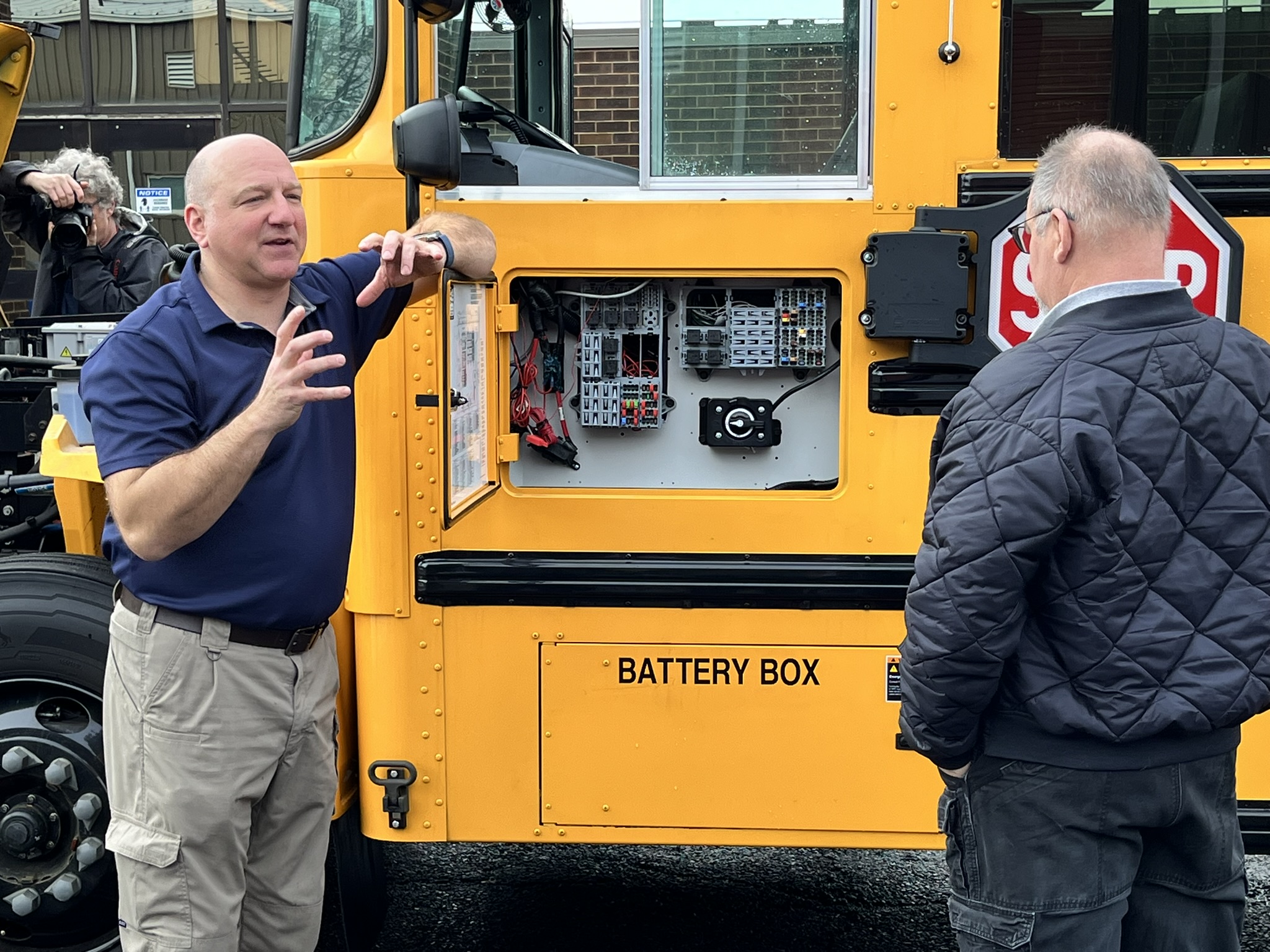
Quick Facts
-
- Based on a review of more than 10 years of data, gasoline and diesel-fueled vehicles are far more likely to catch fire than electric vehicles
- Manufacturers hold student transportation, including electric school buses, to the highest safety standards
- Two strategies school districts can take to minimize risk are 1) working closely with local first responders to understand general and brand-specific practices 2) requiring school transportation providers to upgrade facilities to improve preparedness
- Based on a review of more than 10 years of data, gasoline and diesel-fueled vehicles are far more likely to catch fire than electric vehicles
Questions and Answers
Electric school buses eliminate diesel emissions that we know are unsafe for children and drivers, but what about fires?
While extremely rare, school bus fires are possible with any type of school bus. In general, electric vehicle fires are much less common than in fossil fuel vehicles.
A 2016 USDOT study found that school bus fires in the U.S. occur, on average, slightly more than daily, mostly starting in the engine area, running gear, or wheel area.
Electric school buses replace the diesel and gasoline engines with batteries. Batteries in electric school buses are less likely to catch fire than the internal combustion engines, consistent with the data comparing electric with gasoline passenger vehicles.
How do school bus manufacturers ensure electric school bus safety?
Electric school bus manufacturers leverage a few key strategies to ensure batteries are designed to the highest degree of safety:
- Extensive battery testing along with adherence to global standards
- Enhanced battery chemical stability
- Both automatic and manual electrical disconnect
- Battery management system, including cell isolation
- Roll over resistance
How are school buses tested for safety?
School buses are some of the safest vehicles on the road. Manufacturers maintain the same level of rigorous safety standards and testing for their batteries. Globally-recognized standards like SAE J2929 and ISO 26262 apply to both the batteries as well as the systems that monitor and control them. Cell manufacturers must also meet UL and UN certifications before they are sold and on the road.
What about “thermal runaway?” Isn’t it harder to extinguish electric school bus fires?
It’s true – fires involving batteries differ from those that occur with internal combustion engines. First responders are being trained to handle their unique qualities.
Thermal runaway is a chemical reaction causing a battery thermal event to reignite after it has been extinguished. To minimize the event of a thermal runaway in the first place, manufacturers design buses with Battery Management Systems and Passive Propagation Resistance.
Battery Management Systems optimize temperatures within the battery, ensuring proper operation conditions regardless of external conditions like extreme heat or cold temperatures.
Passive Propagation Resistance (PPR), utilized by NASA, is a localized isolation mechanism: battery packs are made up of thousands of smaller cells – in the rare case of a thermal event within a cell, PPR detects and isolates an affected cell and prevents the incident from spreading to neighboring cells. Sensors throughout the system also provide continuous monitoring.
In the rare event a thermal runaway occurs, they likely take longer to extinguish and emergency responders will need to focus on containing the event. More information is provided in the last FAQ on engaging emergency responders.
Are all electric school bus batteries the same?
No – while all electric school bus manufacturers currently use lithium-ion batteries, they can differ in their chemistry. There are two chemistries predominantly used in electric school buses: lithium-iron-phosphate and nickel-manganese-cobalt. Industry experts believe that lithium-iron-phosphate provides better thermal stability than the nickel-manganese-cobalt combination that is often used in passenger vehicles; manufacturers are split in their offerings, touting benefits for each. New developments may be on their way as battery manufacturers are exploring solid state batteries that would remove fire risk.
What about that CTtransit electric bus that caught on fire in Hamden?
Following 2022’s electric transit bus thermal event in Hamden, local, state, and national officials teamed up to explore causes, improve safety practices, and prevent future incidents. New Flyer, the bus manufacturer, issued a national recall after finding a defect in the fiberglass enclosure that holds the batteries that could result in accumulation of liquid, leading to an electrical short and increased risk of a thermal event. One year later, the electric buses are back in operation and CTtransit’s three divisions have completed facility upgrades to fire suppression systems and fire pumps/hydrants.
What’s the harm with staying with the tried and true diesel buses?
For over 20 years, the dangers of diesel school bus exhaust to the children and young adults riding in them have been well documented, including in a follow-up study of Connecticut school bus riders by a Yale researcher. Diesel exhaust spews fine particles and nitrogen oxides (NOx), including dozens of carcinogens, exacerbating asthma and contributing to other respiratory diseases, with school age children among those most at risk. In addition to these health risks, U.S. diesel CO2 emissions equal 26 percent of our transportation sector’s greenhouse gas emissions.
Do firefighters know how to respond to electric school bus fires?
As for all new technologies, training for electric school buses is rolling out for first responders and mechanics across the country. The National Fire Protection Association offers extensive online and in-person EV safety training. Connecticut is lucky to have one of NFPA’s lead EV safety trainers in Waterbury; he has provided Clean Cities-sponsored training in three Connecticut locations to date.
First responder training in Virginia urged making or reinforcing connections with local emergency responders, communicating efforts early, hosting both classroom and hand-on trainings, involving a towing company, creating electric bus indicators, and exploring ongoing training.
The Firefighters Association of the State of New York offered additional tips, including establishing a point of contact like a technician or advisor, distributing Emergency Response Guides (see below), and acquiring and maintaining proper personal protective equipment.
You can find Emergency Response Guides for first responders for many manufacturers (GreenPower, Lightning eMotors, Navistar/IC Bus, Thomas Built Buses, Proterra) at the National Fire Protection Association’s website. Additional information is available at Blue Bird, Lion Electric, and Thomas Built Buses (Safety Considerations, Battery Safety Blog, General Webpage (with safety considerations included), Safety Circuit brochure).
//////////////////
For more information:
- Clean Cities First Responder Trainings in CT (Greater New Haven Clean Cities, 2024)
- More Power to You (School Transportation News, 2022)
- All About Electric School Bus Battery Safety (Electric School Bus Initiative, 2023)
- Electric Bus Basics (US Department of Transportation, 203)
- Battery Electric Bus (BEB) Initiative, (CT DOT, 2023)
- Risk Management & Loss Control Considerations for Electric Buses, (Vermont School Boards Insurance Trust, 2022)
- Electric Vehicle Safety Training Resources for First and Second Responders (Department of Energy, 2023)
- Technology Innovation Spotlight: Lithium Ion Battery Fires in the News (EPRI, 2023)
- Minimizing Fire Risk for Zero Emission Buses (WSP Australia, 2022)
- Vehicle Fires Involving Buses and School Buses (NFPA, 2006)
- New Study Analyzes School Bus Fires (School Bus Fleet, 2017)
- 10 Safety Recommendations Issued Following Investigation of Oakland, Iowa, School Bus Crash (NTSB, 2019)
- NTSB Issues Safety Recommendation for Fire Suppression in School Buses (Firetrace, 2019)
